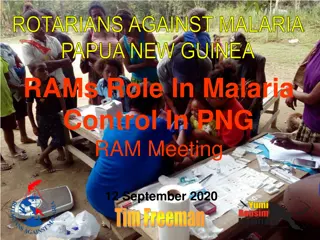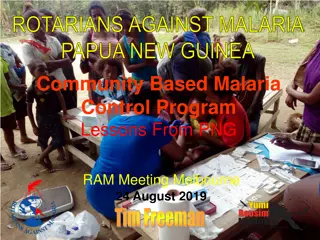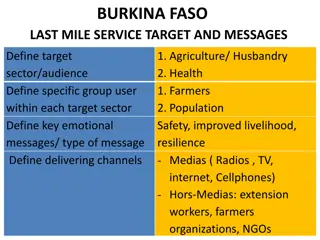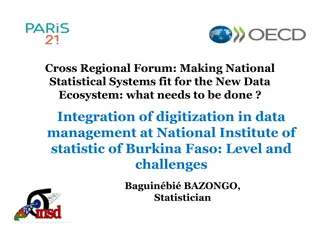Impact of Seasonal Malaria Chemoprevention in Burkina Faso
Exploring the impact of seasonal malaria chemoprevention (SMC) in Burkina Faso using national household surveys. SMC involves administering anti-malaria medication to children during peak transmission seasons to prevent malaria episodes. The study investigates the effectiveness of SMC delivery, coverage, and impact reduction in morbidity through ecological secondary analysis of household data collected from 2010 to 2017.
Download Presentation

Please find below an Image/Link to download the presentation.
The content on the website is provided AS IS for your information and personal use only. It may not be sold, licensed, or shared on other websites without obtaining consent from the author.If you encounter any issues during the download, it is possible that the publisher has removed the file from their server.
You are allowed to download the files provided on this website for personal or commercial use, subject to the condition that they are used lawfully. All files are the property of their respective owners.
The content on the website is provided AS IS for your information and personal use only. It may not be sold, licensed, or shared on other websites without obtaining consent from the author.
E N D
Presentation Transcript
An ecological analysis exploring the impact of seasonal malaria chemoprevention in Burkina Faso using national household surveys (2010 2017) Monica Anna de Cola, Results Measurement Analyst 2020 Annual Meeting of the American Society of Tropical Medicine & Hygiene
Background Seasonal malaria chemoprevention (SMC) is the administration of full courses of anti- malaria medication in areas of highly seasonal malaria transmission sulfadioxine-pyrimethamine and amodiaquine (SPAQ) is administered to children 3 59 months at monthly intervals during the peak transmission season. Goal: to prevent malaria episodes by maintaining therapeutic drug concentrations in the blood during the highest malaria risk period. Typical four-cycle SMC treatment round
SMC in Burkina Faso One of the 11 highest malaria burden countries, with an estimated incidence of 398.7 per 1,000 population at risk1. Malaria is highly seasonal, with a peak coinciding with the rainy season (Jul Oct). The health system is comprised of three levels. The lowest is divided into 70 districts, that are responsible for policy implementation and data reporting. SMC was introduced in 2014 in seven districts. SMC was then gradually scaled up, reaching all 70 health districts in 2019. Map of health districts by year of introduction 1. WHO, 2020. World Health Statistics 2020: Monitoring Health for the SDGs. Geneva, Switzerland: World Health Organization
Effectiveness of SMC Delivery Supply, training, administration Clinical trials indicate SMC prevents up to 75 percent of uncomplicated and severe cases if implemented to quality standards with acceptable levels of resistance. Coverage Reach, adherence, and acceptability Efficacy Drug resistance and timing Impact Reduction in morbidity Logic model for effectiveness of SMC
Measuring impact Methods of measuring impact o Randomised controlled trials Establish causality and may not be required or ethical in settings where efficacy has been demonstrated. o Quasi-experimental Most often used and feasible as they take advantage of programme uptake; may still introduce bias at the group level. o Observational Must use various methods for counterfactual; introduces bias. Triangulation o Impact analysis with multiple data sources and methods strengthen the evidence base, establish causality and address biases in quasi-experimental studies and routine data sources.
Study objective and design Objective: To investigate if the effect of SMC can be observed in household data collected through the Demographic and Health Surveys (DHS) Programme, and to add to the evidence base of impact of SMC when implemented programmatically at scale Design: Ecological secondary analysis Setting: Burkina Faso Timeframe: Apr 2010 Jan 2011; Sep Dec 2014; Nov 2017 Mar 2018 Primary outcomes: Odds of having malaria in an SMC district compared to an non-SMC district in children under five, as diagnosed by rapid diagnostic test (RDT) and microscopy
Data sources DHS: Nationally-representative household surveys collect data on population, health, and nutrition. These include a subset of children 6 59 months tested for malaria via an RDT (detects HRP-2 antigen) and microscopy. Malaria Indicator Survey (MIS): Stand-alone, smaller scale DHS household surveys collect data on standardised malaria indicators; usually occurs during the high transmission season; includes a subset of children 6 59 months tested for malaria via an RDT (detects HRP-2 antigen) and microscopy. Rainfall: Total millimetres of rainfall at that cluster for the month before the blood sample was taken using the inverse distance squared method. Geospatial data: Overlaid spatial data with DHS/MIS cluster location to determine the health district. SMC programme data: SMC indicators not yet included in the DHS/MIS; programme data was used to identify districts that received SMC
Statistical methods A multilevel generalised additive model for binary outcomes (case vs no case) with a logit link function with random intercepts for health district Adjusted by SMC status, year (2014, 2017, 2018), age, sex, use of a net the night before, wealth quintile, residence (urban vs rural), rain, and baseline prevalence (calculated from the 2010 survey before SMC was introduced).
Results SMC Protective Period 2017/18 MIS 2014 MIS Data from 16,723 children were included in the analysis. 2010 DHS o GPS location for some clusters were not recorded (6.06 percent). Jan Feb Mar Apr May Jun Jul Aug Sept Oct Nov Dec Survey data collection timing compared to rainy season Survey timing compared to rainy season and SMC protective period: Stratum specific characteristics and percent of malaria in children 6-59 months o 2010 DHS survey is a much larger survey and took place over a longer period (Apr 2010 Jan 2011). 2017 MIS started late and had disruptions (Nov 2017 Mar 2018). Variable SMC Category No Yes 2010 2014 2017/18 n (%) Malaria (%) 4,623 (44.54) 258 (42.36) 4,269 (74.45) 3,842 (64.72) 1,039 (20.56) 10,380 (94.46) 609 (5.54) 5,734 (34.29) 5,936 (35.50) 5,053 (30.22) Year o
Results Adjusted odds ratios for malaria in children 6-59 months in Burkina Faso Variable SMC Category No Yes 2014 2017 2018 6 11 months 12 23 months 24 35 months 36 47 months 48 59 months Female Male No Yes Poorest Poor Middle Richer Richest Rural Urban Fully Adjusted OR 1.00 (base) 0.44 (0.32 0.61) 1.00 (base) 0.52 (0.31 0.86) 0.39 (0.23 0.66) 1.00 (base) 1.41 (1.18 1.69) 2.03 (1.70 2.42) 2.33 (1.96 2.77) 2.29 (1.92 2.73) 1.00 (base) 0.96 (0.88 1.05) 1.00 (base) 0.92 (0.84 1.02) 1.00 (base) 0.93 (0.81 1.06) 0.81 (0.70 0.93) 0.70 (0.60 0.81) 0.36 (0.28 0.47) 1.00 (base) 0.40 (0.33 0.49) Wald P-Value Malaria diagnosis by microscopy: Odds ratio: 0.44, 95% CI 0.32 0.61, p<0.001 Malaria diagnosis by RDT: Odds ratio 0.38, 95% CI 0.28 0.50, p<0.001 <0.001 Year <0.001 <0.001 Age <0.001 <0.001 <0.001 <0.001 Sex 0.85 Net Use 0.05 Wealth 0.37 0.04 <0.001 <0.001 Residence <0.001
Discussion Limitations SMC exposure was implied at the population level. Displacement of GPS locations of clusters may result in children being assigned an alternate SMC status. HRP-2 RDTs can show a positive result for malaria four to five weeks after clearance of the parasite. Transmission intensity and other interventions was accounted for by random effects grouped at the district level. Next Steps Include other co-variables such SMC programme indicators and temperature. Assess for decaying effect after SMC protective period. Triangulate with routine data.
Acknowledgements Co-authors: Benoit Sawadogo1, Sol Richardson2, Christian Rassi2, Arantxa Roca- Feltrer2 1Malaria Consortium Burkina Faso 2Malaria Consortium Thanks to the Demographic and Health Surveys Program; the Burkina Faso Meteorological Agency; the Burkina Faso Mapping Institute; Lucy Okell and Patrick Walker at Imperial College London























